
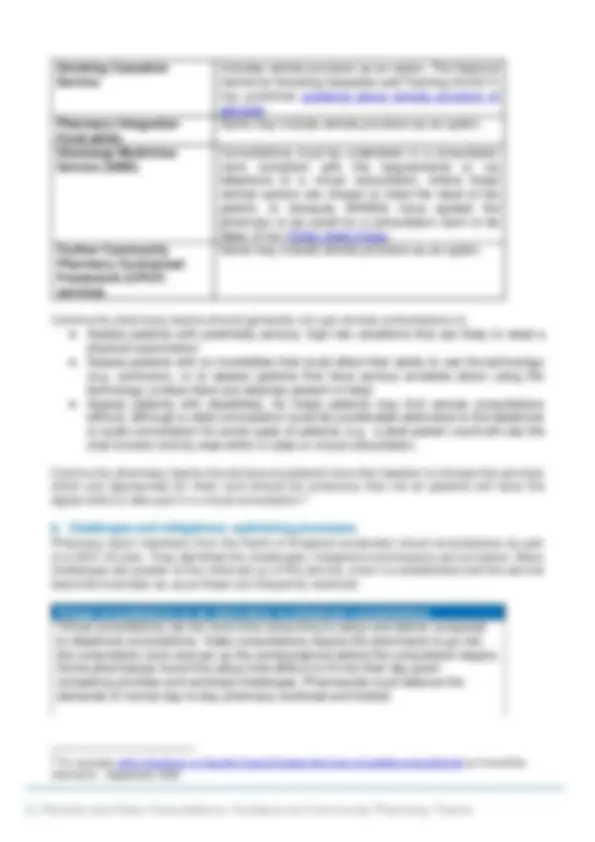
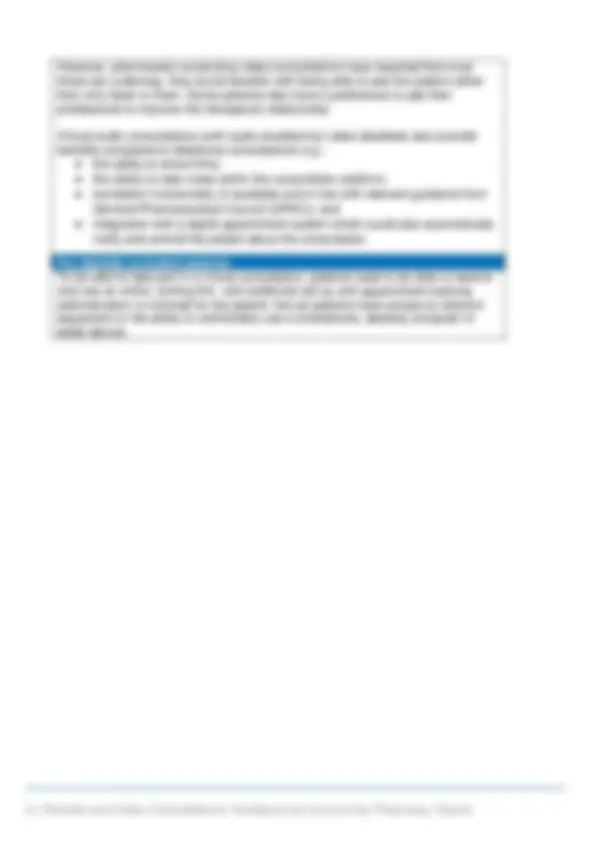
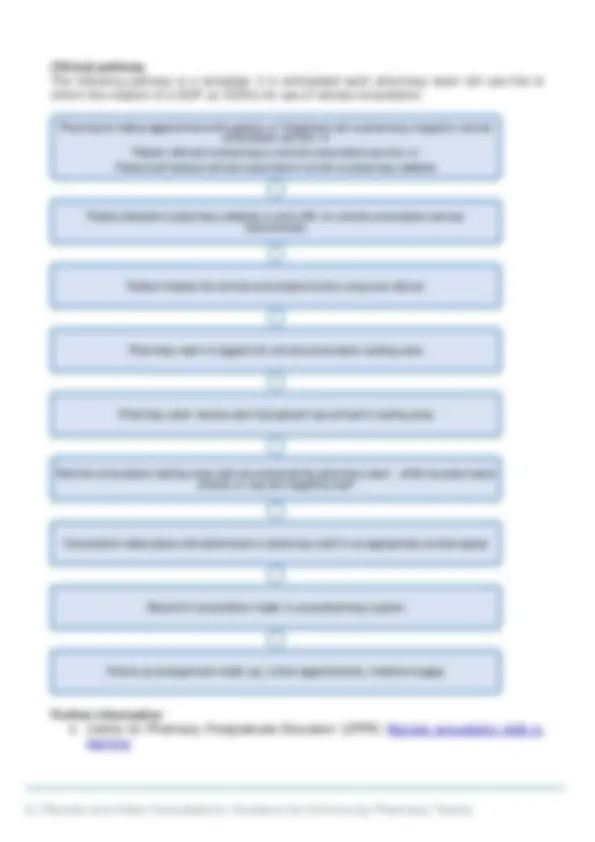
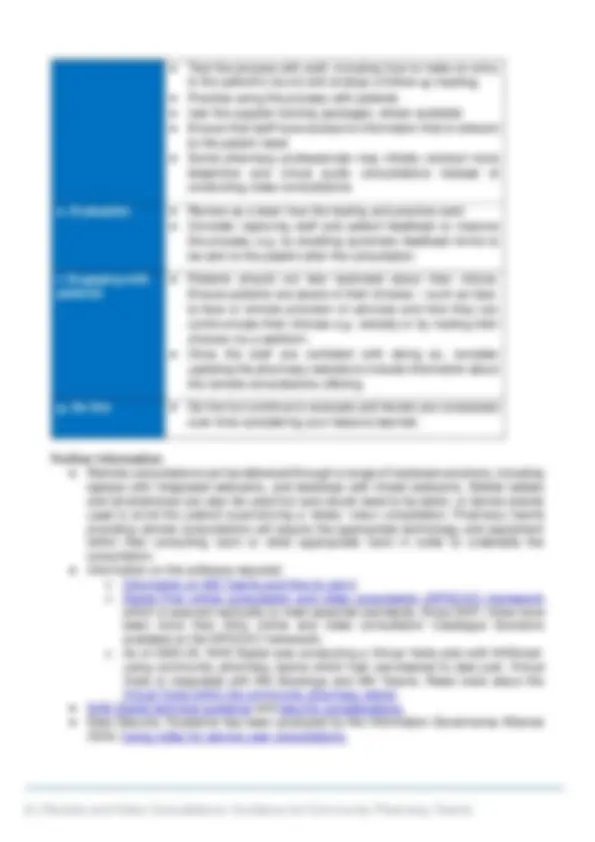
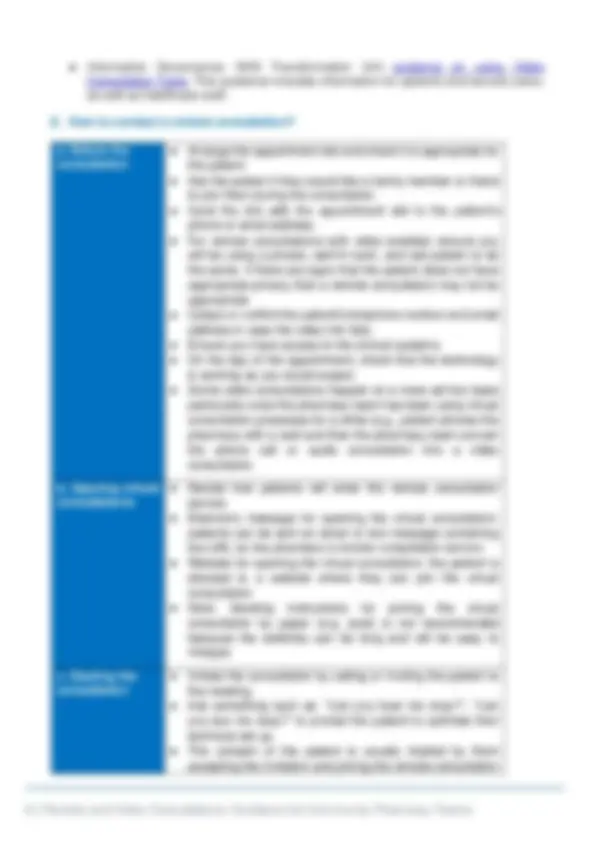
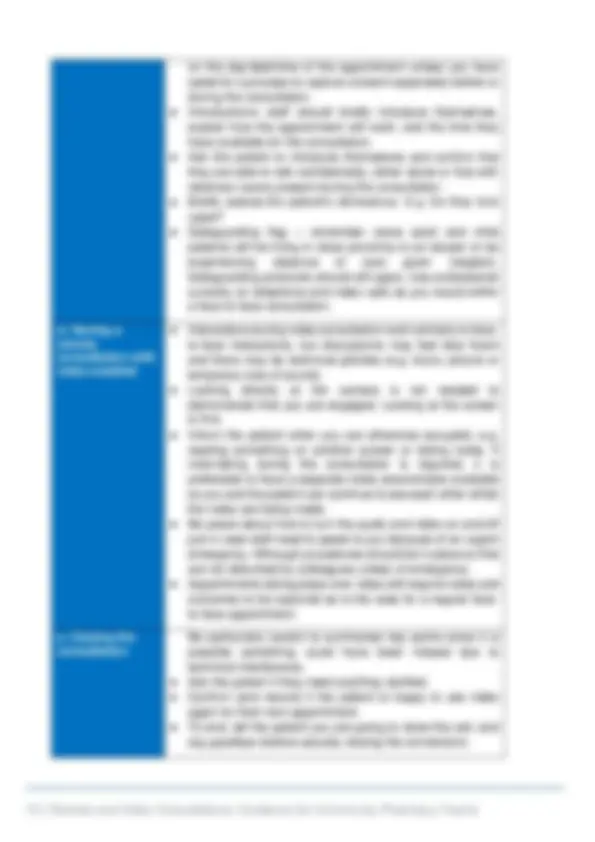


Study with the several resources on Docsity

Earn points by helping other students or get them with a premium plan


Prepare for your exams
Study with the several resources on Docsity

Earn points to download
Earn points by helping other students or get them with a premium plan
Community
Ask the community for help and clear up your study doubts
Discover the best universities in your country according to Docsity users
Free resources
Download our free guides on studying techniques, anxiety management strategies, and thesis advice from Docsity tutors
Guidance for community pharmacy teams on the implementation and use of remote consultations, specifically telephone, video, and virtual audio consultations. the benefits of remote consultations, when they should be considered, challenges and mitigations, and steps for setting up the system. It also includes patient communication materials.
Typology: Exercises
1 / 12

This page cannot be seen from the preview
Don't miss anything!







1. Introduction This practical guide assists community pharmacy teams planning to conduct remote consultations with patients. Remote consultations have played an important role in the NHS response to the Covid- 19 pandemic. The guide includes lessons learned from the Covid-19 pandemic within primary and secondary care, where the use of remote consultations has greatly increased.^1 We want to continue to support the uptake of remote consultations across any appropriate community pharmacy service. 2. What is a remote consultation? In a remote consultation, your appointment will take place between yourself and your patient on the telephone or through the internet. There are several types of remote consultation which are referred to within this guidance: ● Telephone consultation : Where the patient and clinician discuss the matter using the phoneline. ● Virtual consultation : Is conducted using the internet using remote consultation software. This is a not a face-to-face consultation and is not a telephone consultation. Some virtual consultations could be audio only if the clinician and patient both have disabled video. ● Video consultation : Is a virtual consultation in which video and audio is enabled. 3. Benefits The provision of remote consultations within a community pharmacy setting can support the delivery of patient care. Offering remote consultations alongside face-to-face pharmacy visits might help: ● Increase patient choice concerning how they access services potentially helping reduce demand on other parts of the NHS. ● Reduce patients’ requirements to travel, helping vulnerable patients and those living in isolated rural areas. (^1) NHS Digital. Appointments in general practice — March 2020. Classification: Official Publication approval reference: PAR
● Contribute to a greener NHS. ● Delivery of services provided via the Community Pharmacy Contractual Framework (CPCF)^2 ● Enables physical distancing : Remote consultation enables services to continue to be provided without potential exposure to infectious diseases and reduces footfall in NHS premises. ● Delivers person centred and convenient care : Remote consultation enables people to attend appointments from the location of their choice. This can reduce travel, minimise time taken off work or school, or reduce the need for carers to support. It also helps vulnerable patients and those living in isolated rural areas. ● Addresses environmental imperatives : by reducing travel, remote consultation improves the move towards ‘net zero’ and the carbon footprint of services.
4. Evidence A number of randomised trials have focused on the use of video consultations with patients and found high satisfaction rates among patients and clinicians.^3 ,^4 Evidence has also reported on patient views, patient outcomes, cost effectiveness, safety, technical issues, impact of video consultations on healthcare delivery, and quality of consultations.3, 5. When should remote consultations be considered? Pharmacists should decide when it is clinically appropriate to use remote consultations. In some circumstances, telephone consulting or virtual audio consulting will be sufficient, in others video consultations will provide additional clinical information and improved communication with patient, and in some cases a face-to-face consultation will be required. Existing specifications and guidance support community pharmacy remote consultations: Pharmacy Service Rationale New Medicine Service (NMS) Service specification refers to ability to use ‘telephone call’, which can also be a remote consultation (audio or video), with patient agreement. NHS Community Pharmacist Consultation Service (CPCS) - both from NHS 111 and GP referral to CPCS Service specification includes reference to use of remote consultation and use of video, with patient agreement. Local Authority commissioned services e.g. sexual health consultations and smoking cessation services A rationale may be provided within local specifications or amendments to these, depending on the view of the local commissioner and service delivery organisations. (^2) NHS England and NHS Improvement. Community Pharmacy Contractual Framework 2019- 2024 – February 2022. (^3) Car J, Choon-Huat Koh G, Sym Foong P, Wang, C J. Video consultations in primary and specialist care during the covid-19 pandemic and beyond. BMJ 2020; 371. (^4) The Scottish Government’s national public consultation on video consulting illustrates related views and uses as well - September 2020
However, pharmacists conducting video consultations have reported that once these are underway, they found benefits with being able to see the patient rather than only listen to them. Some patients also have a preference to see their professional to improve the therapeutic relationship Virtual audio consultations (with audio enabled but video disabled) also provide benefits compared to telephone consultations e.g.: ● the ability to share links; ● the ability to take notes within the consultation platform; ● translation functionality (if available and in line with relevant guidance from General Pharmaceutical Council (GPhC)); and ● integration with a digital appointment system which could also automatically notify and remind the patient about the consultation. For digitally excluded patients To be able to take part in a virtual consultation, patients need to be able to receive and use an online ‘joining link’, and additional set up and appointment booking administration is involved for the patient. Not all patients have access to relevant equipment or the ability to comfortably use a smartphone, desktop computer or tablet device.
Clinical pathway The following pathway is a template: it is anticipated each pharmacy team will use this to inform the creation of a SOP (or SOPs) for use of remote consultation. Further information ● Centre for Pharmacy Postgraduate Education (CPPE) Remote consultation skills e- learning Pharmacist makes appointment with patient, or Telephone call to pharmacy triaged to remote consultation service, or Patient referred to pharmacy's remote consultation service, or Patient self-selects remote consultation via link on pharmacy website Patient directed to pharmacy website or sent URL for remote consultation service electronically Patient intiates the remote consultation button using own device Pharmacy team is logged into remote consultation waiting area Pharmacy team receive alert that patient has arrived in waiting area Remote consultation waiting area calls are answered by pharmacy team - either by pharmacist directly or may be triaged by staff Consultation takes place with pharmacist or pharmacy staff in an appropriate, private space Record of consultation made in usual pharmacy system Follow up arrangement made, eg, further appointments, medicine supply
● Prepare patient information, including the type of technology they will need to attend the virtual appointment (the NHS patient guide may be of use, and is available - here and here) ● Set up the equipment in the chosen room and check that the equipment works as expected e.g. that the microphone works properly and that there is not background noise ● Check that confidential information is not visible to the patient during a video consultation ● If a digital appointment system will auto-notify patients with text and email reminders, you should check what will happen if patients attempt to reply to these reminders e.g. will an automated reply notification be issued to the patient which explains that the patient should contact the pharmacy using the usual communication channel instead? c. Set up the workflows ● The most important point where remote consulting services often fail is not spending enough time on the processes/ workflows. These need to be co-designed with the pharmacy team and also with patient input to ensure the service is easy to use. ● Put standard operating processes in place for scheduled and unscheduled appointments ● Ensure that staff will be aware about when you are conducting a remote consultation so that you will not be disturbed unless there is an emergency ● Make contingency plans for steps to take if connectivity fails e.g. contacting patients by telephone so that the appointment can be adjusted, or a telephone consultation can take place at the allotted time instead of a virtual consultation. ● Decide how appointments should be booked and recorded. ● Define how patients will contact the pharmacy to make an appointment. ● Ensure patients are given information about how to attend. This would usually be referring to the text message/email reminder. ● Identify who within the pharmacy team will have administrative rights for the virtual consultation software. This will enable them to add and remove staff member users (e.g. locums) and messages to patients. d. Train, test and practise ● Training such as the CPPE Remote consultation skills e- learning referenced earlier will be important ● Train staff to use the new system and assess they are competent ● Test the technical aspects by making dummy calls
● Test the process with staff, including how to make an entry in the patient’s record and arrange a follow-up meeting ● Practise using the process with patients ● Use the supplier training packages, where available ● Ensure that staff have access to information that is relevant to the patient need ● Some pharmacy professionals may initially conduct more telephone and virtual audio consultations instead of conducting video consultations e. Evaluation ● Review as a team how the testing and practice went ● Consider capturing staff and patient feedback to improve the process, e.g. by enabling automatic feedback forms to be sent to the patient after the consultation f. Engaging with patients ● Patients should not feel restricted about their choice. Ensure patients are aware of their choices – such as face- to-face or remote provision of services and how they can communicate their choices e.g. verbally or by making their choices via a webform. ● Once the staff are confident with doing so, consider updating the pharmacy website to include information about the remote consultations offering. g. Go live ● Go live but continue to evaluate and iterate your processes over time considering your lessons learned. Further information ● Remote consultations can be delivered through a range of hardware solutions, including laptops with integrated webcams, and desktops with linked webcams. Mobile tablets and smartphones can also be used but care would need to be taken, or device stands used to avoid the patient experiencing a ‘shaky’ video consultation. Pharmacy teams providing remote consultations will require the appropriate technology and equipment within their consulting room or other appropriate room in order to undertake the consultation. ● Information on the software required: o Information on MS Teams and how to use it. o Digital First online consultation and video consultation (DFOCVC) framework which is assured nationally to meet essential standards. Since 2021, there have been more than thirty online and video consultation Catalogue Solutions available on the DFOCVC framework. o As of 2022-23, NHS Digital was conducting a Virtual Visits pilot with NHSmail- using community pharmacy teams which had volunteered to take part. Virtual Visits is integrated with MS Bookings and MS Teams. Read more about the Virtual Visits within the community pharmacy sector. ● NHS Digital technical guidance and security considerations. ● Data Security: Guidance has been produced by the Information Governance Alliance (IGA): Using video for service user consultations.
on the day/date/time of the appointment unless you have opted for a process to capture consent separately before or during the consultation. ● Introductions: staff should briefly introduce themselves, explain how the appointment will work, and the time they have available for the consultation. ● Ask the patient to introduce themselves and confirm that they are able to talk confidentially, either alone or that with relatives/ carers present during the consultation. ● Briefly assess the patient’s demeanour. E.g. Do they look upset? ● Safeguarding flag – remember some adult and child patients will be living in close proximity to an abuser or be experiencing absence of care given (neglect). Safeguarding protocols should still apply. Use professional curiosity on telephone and video calls as you would within a face-to-face consultation. d. Having a remote consultation with video enabled ● Interactions during video consultation work similarly to face- to-face interactions, but discussions may feel less fluent and there may be technical glitches (e.g. blurry picture or temporary loss of sound). ● Looking directly at the camera is not needed to demonstrate that you are engaged. Looking at the screen is fine. ● Inform the patient when you are otherwise occupied, e.g. reading something on another screen or taking notes. If note-taking during the consultation is required, it is preferable to have a separate notes area/window available so you and the patient can continue to see each other whilst the notes are being made. ● Be aware about how to turn the audio and video on and off just in case staff need to speak to you because of an urgent emergency. Although procedures should be in place so that are not disturbed by colleagues unless of emergency. ● Appointments taking place over video still require notes and outcomes to be captured as is the case for a regular face- to-face appointment. e. Closing the consultation Be particularly careful to summarise key points since it is possible something could have been missed due to technical interference. ● Ask the patient if they need anything clarified. ● Confirm (and record) if the patient is happy to use video again for their next appointment. ● To end, tell the patient you are going to close the call, and say goodbye (before actually closing the connection).
f. After the consultation ● Decide if you need to make a clinical record of the consultation in the appropriate location (e.g. PMR) ● Arrange for any medicines required by the patient to be prepared in advance of the patient coming to the pharmacy and stored/labelled appropriately so other members of the team are aware that advice has been provided remotely ● Arrange for any prescriptions required by the patient to be prepared and supplied to the patient ● Arrange for any follow up required, e.g. patient coming to the pharmacy for an in-person examination, referral to another healthcare professional Further information ● The University of Oxford have published a quick step-by-step guide aimed at NHS staff which covers practical tips on running a video consultation, as well an online consultation toolkit for primary care in January 2020. ● Pharmacists and their teams can use the General Pharmaceutical Council’s Guidance for registered pharmacies providing pharmacy services at a distance, including on the internet and advice and guidance in relation to delivering remote consultations whether within the pharmacy or remotely. ● PSNC guidance ● Royal Pharmaceutical Society guidance (registration needed) ● National Royal College of General Practitioners guidance ● The National Pharmacy Association (NPA) has confirmed that NPA indemnity insurance extends to cover video/telephone consultations if there are secure systems (recommended by the GPhC) in place, but that this insurance does not cover remote prescription checking.
9. Patient communication materials to assist with remote consultations 9.1 NHS video consultations leaflet This is a quick step-by-step guide for patients which explains the benefits of a video consultation, and provides practical guidance on how to start, have and finish a video consultation. 9.2 Other key messages for patients to assist their preparation Consider communicating to patients points such as those set out below, e.g. via email. a. Decide if video is right for you ● Would you prefer a face-to-face consultation or a remote consultation (phone or virtual)? If a telephone or audio call will do, or a face-to-face consultation is more appropriate, a remote consultation with video enabled may not be needed? ● If video is used: Please look at the screen. ● Use the screen camera to show things, e.g. a rash ● Some video consultations could happen on a more ad- hoc basis e.g. if you phoned us and we invited you to login into to a virtual consultation with the pharmacist.